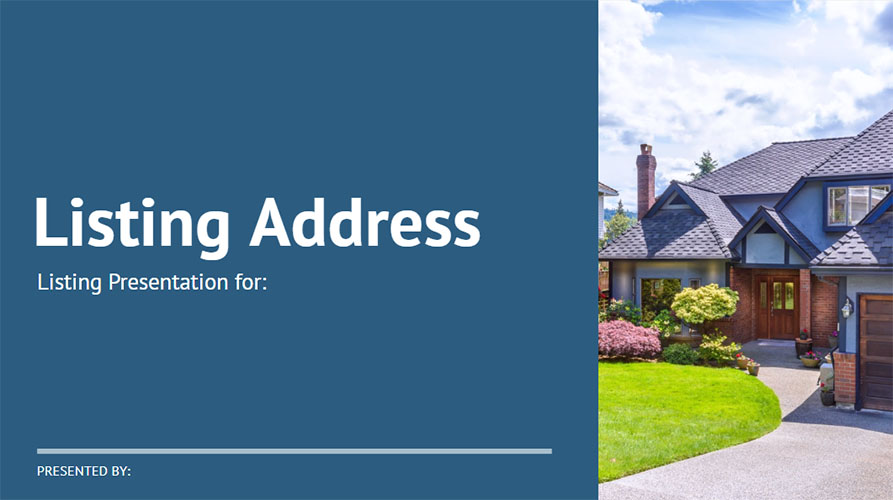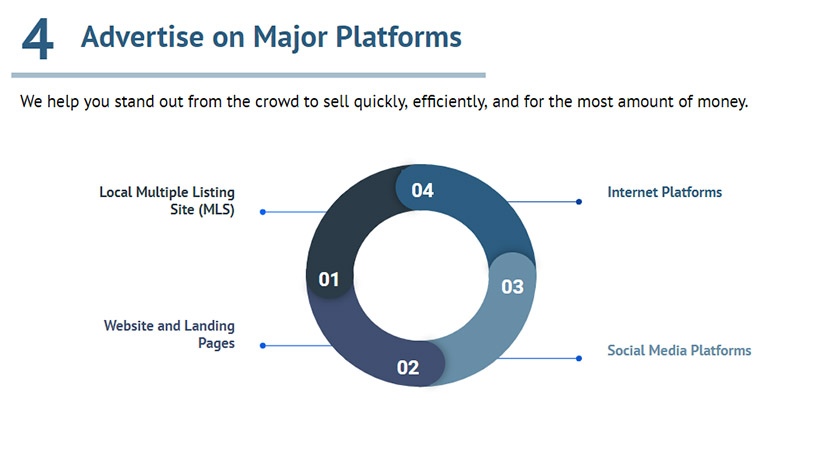Real estate professionals are constantly seeking innovative ways to stand out and secure listings in a competitive market. A compelling listing presentation makes a memorable impression on potential clients and showcases your value as an agent. The quality of your presentation can be the difference between securing a new listing or watching it go to a competitor.
Download the free listing presentation template below to get a head start. Then, read my comprehensive guide to elevate your presentation and win more listing clients.
What Are Listing Presentations?
A listing presentation is a key tool in a real estate professional’s arsenal to impress potential clients and secure new real estate opportunities. It’s a personalized pitch that agents use to demonstrate their expertise, market knowledge, and the unique services they offer. This presentation typically includes an analysis of the current real estate market, a tailored marketing strategy, pricing strategies based on comprehensive market data, and a detailed plan of how the agent will manage the sales process from listing to closing.
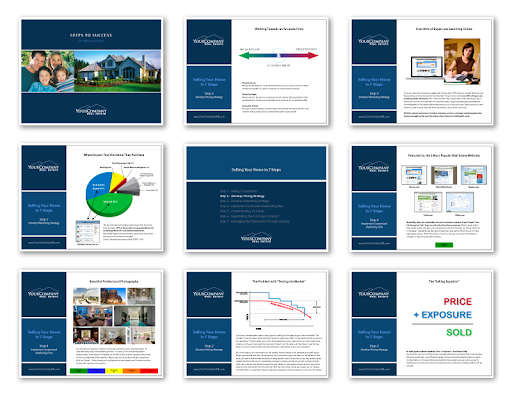
Real estate listing presentation examples (Source: Best Listing Presentation)
The goal is to establish trust and confidence, showing the property owner that the agent is the best choice to sell their property efficiently and at the best possible price. Adhere to the steps below for crafting a compelling real estate listing presentation.
Step 1: Introduce Your Personal Expertise
Discussing personal expertise is a great way to start a listing presentation because it distinguishes you as a real estate professional from competitors and builds trust with potential clients. This section of the presentation allows you to highlight your unique skills, experience, and successes in the real estate market. It’s an opportunity to share your knowledge of the local area, your proficiency in negotiating deals, and your track record of successful sales and satisfied clients.
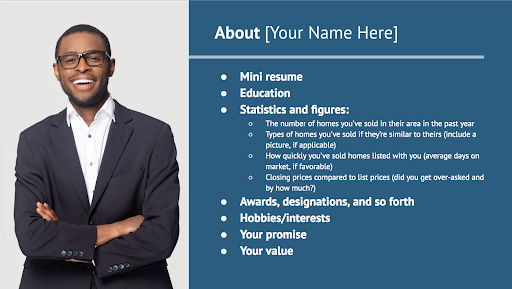
Example slide on agent’s expertise
Illustrate your problem-solving approach and commitment to staying abreast of market trends. Detailing your expertise reassures clients of your ability to handle their listing with professionalism and care and establishes a good rapport. Here is some additional information to include in the first part of your listing presentation:
- Brokerage-specific tools and resources: Highlight tools you can leverage from your brokerage, like advanced market analysis software, proprietary client portals, and an extensive network of real estate professionals. These resources not only underscore your brokerage’s commitment to leveraging technology and expertise for successful sales, but also demonstrate your ability to provide superior service to your clients.
- History with similar listings: Your experience will play a large role in how your clients view your capability to handle their listings. Showcasing your track record with properties similar to theirs can provide reassurance and build trust. Illustrate this by sharing success stories, before-and-after sales statistics, and testimonials from satisfied clients. Highlight how your tailored strategies have overcome unique challenges and led to successful outcomes.
- Track record of success: Demonstrating your achievements through detailed case studies, highlighting significant sales you’ve navigated, and showcasing client testimonials can solidify your reputation as a skilled real estate professional. Share metrics such as reduced days on market, sales prices achieved relative to listing prices, and the volume of transactions completed. This information provides tangible evidence of your ability to exceed client expectations.
Step 2: Present Comprehensive Market Data
This crucial step demonstrates the agent’s thorough understanding of the current market conditions and sets realistic expectations for property owners regarding the sale price and timeline. Agents can substantiate their recommended pricing and marketing strategies by effectively leveraging a detailed market analysis. Data points to consider in this section are days on market, absorption rate, inventory supply, and price per square foot.
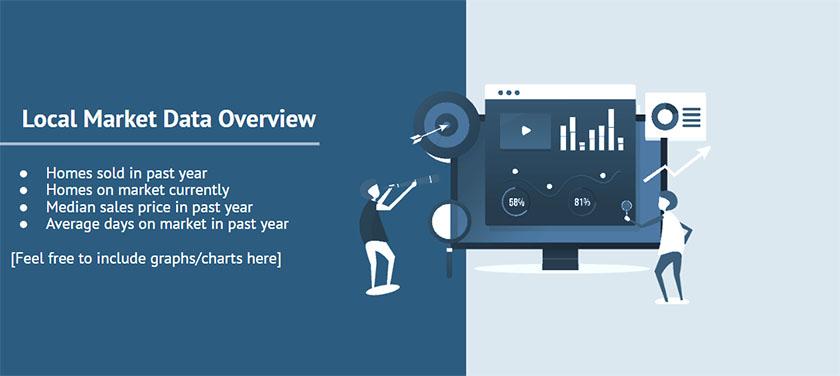
Local market data for presentation
To gather the indispensable market data necessary for a real estate listing presentation, agents can utilize a range of reputable sources:
- Local Multiple Listing Service (MLS): The primary resource for up-to-date information on recent sales, active listings, and market trends specific to the property’s area.
- Real estate market reports: Produced by well-regarded firms like the National Association of REALTORS® (NAR), these reports provide valuable insights into broader market dynamics and trends.
- Government and industry publications: Sources for economic indicators and analysis directly impacting real estate values and market conditions.
- Online real estate platforms: Websites and applications like Zillow that offer real-time data on property listings, price trends, and neighborhood market statistics.
Effectively conveying this market data to property owners is as important as gathering it when pitching for a new listing. Agents should utilize clear graphs and charts to represent market trends, making complex data more accessible visually. By focusing on information specific to the property’s location, type, and price range, agents can tailor their presentation to address the unique concerns and interests of the property owner. Additionally, providing a narrative that explains what the data means for the sale of their property helps owners understand the rationale behind the agent’s pricing and marketing strategies.
Step 3: Outline the Sales Process
An effective realtor listing presentation will include a thorough review of the sales process. This provides property owners with a transparent and step-by-step guide of what they can expect from the time their property is listed until the sale is finalized. If a homeowner has worked with another agent from another brokerage, the sales process may differ, and you want to ensure there is no confusion on how you’ll handle the listing.
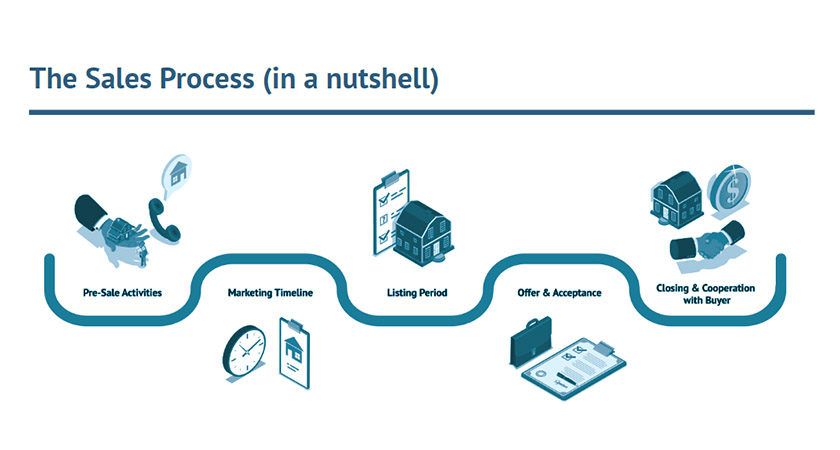
Outline of the sales process
The various phases of the sales process are:
- Prelisting activities: Discuss preparations necessary to make the property ready for the market, such as home improvements, staging, and professional photography. Highlight the importance of setting the right listing price through comparative market analysis.
- Marketing timeline: Articulate to the property owner the strategic steps you’re planning to promote their listing and obtain new leads effectively. These activities should include photography, social media, email campaigns, print marketing, open houses, private showings, etc.
- Listing period: Outline the marketing strategies that will be employed to promote the listing, including listing on the MLS, digital marketing efforts, social media promotion, and hosting open houses. Explain how you will communicate with the seller about showing schedules and feedback from potential buyers.
- Offer and acceptance: Detail the process of receiving offers, how they will be evaluated and presented to the seller, and the negotiation strategies to ensure the best possible outcome. Emphasize your expertise in navigating multiple offers and securing favorable terms for the seller.
- Closing process: Describe the steps from accepting an offer to the final closing, including managing the inspection process, addressing any contingencies, coordinating with escrow and title companies, and ensuring all legal and financial paperwork is completed accurately and on time. Highlight your role in facilitating a smooth transition to closing, ensuring all parties are informed and prepared for the final steps.
Step 4: Prepare the Home to Sell
Now that you’ve covered the generalities of the local market, it’s time to concentrate mainly on your seller’s house. It’s important to establish expectations for the seller while getting ready to sell their house, even if you haven’t been to the home or are just seeing it for the first time. The client must know that it is their responsibility to ensure that the property is in excellent condition to maximize value.
A few things you want to cover are the following:
- Decluttering: Often, less is more when it comes to furniture. Many homeowners have more possessions than they actually need. Your seller might have to rent a storage unit to house extra stuff and remove furniture to make the place more presentable.
- Depersonalizing: Buyers must be able to visualize living there. The buyer can imagine themselves living in the house more easily if family photos, nameplates, and other personal belongings are taken down.
- Cleaning: A dirty home is challenging to sell because no one wants to inherit a mess. If pets are in the house, the owners must thoroughly clean or contact a cleaning company.
- Repairs: It’s to a seller’s best advantage to see that repairs are finished right away, especially when the inspection is approaching, since some buyers don’t want to purchase a home because they have to make repairs. Depending on the house’s condition, this could be anything from a damaged cabinet hinge or leaky faucet to upgrading the electrical box or replacing the roof.
- Renovations: In some circumstances, remodeling a room or other area of the house can considerably raise the value of your property. For instance, if remodeling the basement bathroom costs $5,000 and increases the home’s value by $15,000, it might be worthwhile for the seller to invest their time and money in the project.
It is crucial to go over these details with your client because they are in charge of them and since you don’t reside at their residence. Be prepared to offer suggestions for reliable, licensed contractors and nearby cleaning companies. Additionally, remember that these actions must be finished within a specific time to promote, list, and show the property to potential buyers.
Step 5: Develop & Explain Pricing Strategies
This is probably one of the most important pieces of the real estate listing presentation that a seller will be interested in hearing. This step involves a detailed analysis of comparative market data, considering factors like location, property condition, and current market trends to establish a competitive yet realistic price. By explaining the rationale behind the recommended pricing strategy, real estate professionals can help property owners understand the balance between attracting potential buyers and maximizing the sale price.
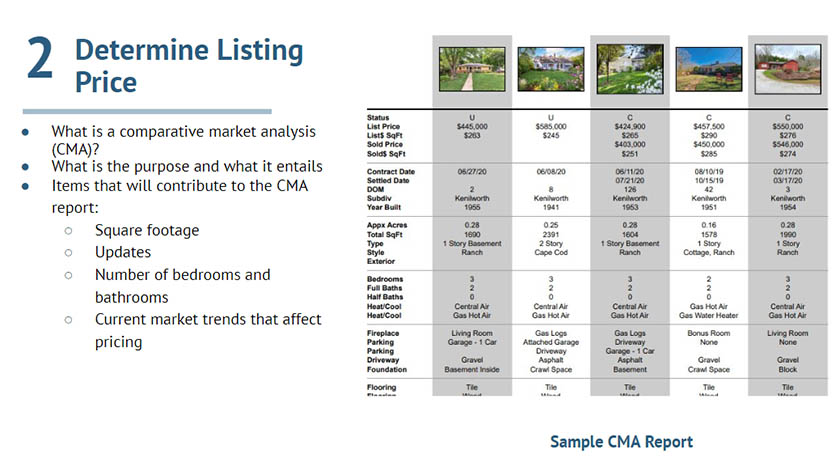
Sample comparative market analysis (CMA) report
As a part of this discussion, agents should also cover how pricing can be adjusted based on market feedback and the importance of flexibility in pricing to respond to market changes or prolonged selling periods. Ultimately, a well-thought-out pricing strategy sets the stage for a successful sale, ensuring the property is positioned attractively in the market from the outset.
Step 6: Detail Effective Marketing Strategies
The best listing presentations showcase effective marketing strategies that are pivotal in elevating the property’s visibility and amplifying its perceived value. In this phase, it’s essential to elaborate on the impactful marketing tactics to ensure the property is positioned attractively to captivate the ideal buyers.
Key marketing strategies to consider incorporating in this section of the real estate presentation:
- High-quality photography and videography: Professional photos and videos that showcase the property’s best features, highlighting its appeal to potential buyers.
- Virtual tours: Offering 360-degree virtual tours to allow potential buyers to explore the property online, providing a more immersive experience.
- Listing on third-party websites: Ensuring the property is listed on popular real estate platforms and websites to maximize visibility among prospective buyers.
- Social media campaigns: Utilizing social media platforms to target specific demographics and engage potential buyers with attractive visuals and compelling property descriptions.
- Email marketing: Sending out detailed and visually appealing email blasts to a curated list of potential buyers and real estate agents to generate interest and leads.
- Open houses: Hosting open houses to give potential buyers a firsthand look at the property, helping them visualize living there.
- Direct mail campaigns: Employing targeted direct mail campaigns to reach potential buyers in specific neighborhoods or demographics.
- Staging: Professionally staging the home to enhance its appeal, making it more inviting and attractive to buyers during viewings and photography.
- SEO-optimized property descriptions: Crafting detailed, engaging, and search engine optimized (SEO) descriptions for listings to improve searchability and attract more online viewers.
- Networking with other agents: Leveraging professional networks to spread the word about the listing, reaching buyers through other agents in the community.
Step 7: Conduct Showings & Open Houses
The process of showings and open houses is critical to selling a home. This process allows you to generate leads for your listing and gives you firsthand feedback on buyers interested in your property. Sellers may be apprehensive about letting strangers into their homes, so this is a time to reassure them of the safety measures and professional protocols in place to protect their privacy and property.

Explain to sellers how showings and open houses will work
Ways to navigate the open house process:
- Highlight the critical role of showings and open houses in the selling process to alleviate seller concerns.
- Explain that showings and open houses are conducted with strict supervision, ensuring access is limited to qualified buyers or licensed agents for security and efficiency.
- Emphasize the benefits of showings and open houses, such as providing a platform to present the property in its best light, thereby increasing the likelihood of receiving competitive offers.
- Encourage sellers to view these events as opportunities to highlight the value of their home to potential buyers.
- Suggest practical preparation steps for sellers, including securing valuables, depersonalizing living spaces, and ensuring the home is clean and inviting.
- Discuss and agree on ideal showing dates and times that accommodate the seller’s schedule to avoid erratic scheduling, which can lead to missed opportunities and increased stress.
- Advocate for setting a consistent schedule for showings and open houses, allowing sellers to organize their personal schedules around these key marketing activities and making the process predictable and manageable.
Step 8: Navigate Offers & the Closing Process
Agents should inform their sellers about how they’ll navigate the offers and closing process of the sale. This includes handling counteroffers, addressing contingencies, and ensuring all legal and financial requirements are met. Asking the seller specific questions during this step not only aids in establishing a clear strategy for negotiations but also ensures that you are aligned with your seller’s expectations and priorities.
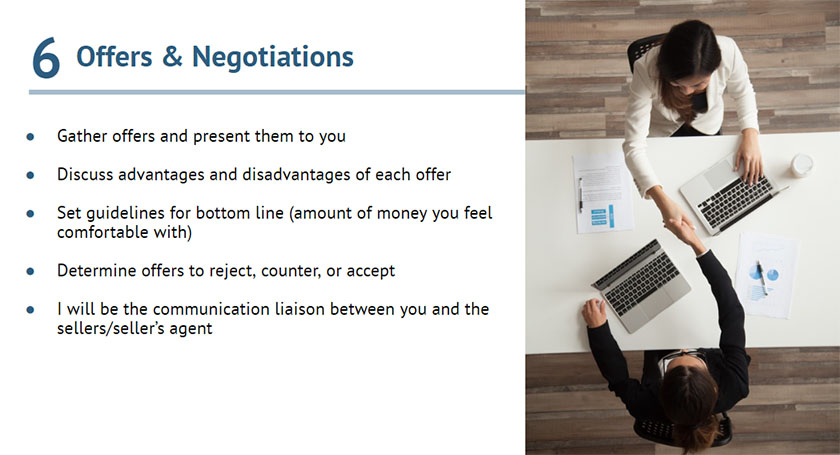
Offer and negotiation tactics
Questions you may want to ask your seller to help guide them through this process include:
- What is your minimum acceptable sale price, and how flexible are you on pricing?
- Are there any specific terms or conditions you require in the sale?
- How quickly are you looking to close, and are there any deadlines we need to consider?
- What are your priorities in negotiating this sale (e.g., price, closing date, contingencies)?
- Have you identified any potential issues with the property that could affect the sale or negotiation process?
- Are you prepared to make repairs or offer credits based on the inspection report?
- How do you prefer to communicate during the negotiation and closing process, and how often would you like updates?
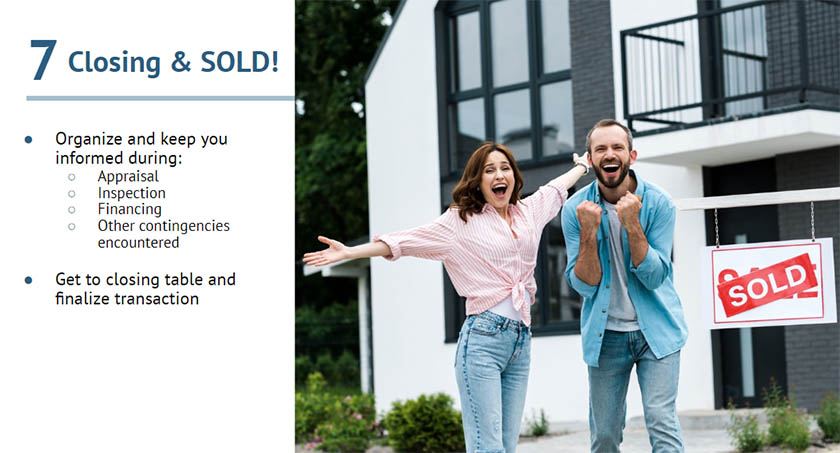
Sales closing suggestions
After walking through your offer process, you’ll want to touch briefly on the closing process if your seller is a first-time or inexperienced homeseller. This is an opportunity to answer any final questions they may have or share the real estate closing checklist with them so they are better prepared when their home hits the market.
Step 9: Implement Follow-up Strategies After the Presentation
Following up after the presentation is essential for maintaining engagement with property owners and demonstrating your commitment to their success. This is very important as you may not be the only one vying for the opportunity. Follow-up strategies may include providing additional information requested during the presentation, answering new questions that arise, and offering updates on market conditions or feedback from potential buyers.
Real estate professionals should arrange a follow-up time to visit the property to discuss the listing price and review the CMA in greater detail. Following up promptly and finding alternative ways to keep the dialogue open with the homesellers helps reinforce your capabilities as their listing agent and helps you transition into the selling process.
Additional Tips for a Successful Listing Presentation
A compelling listing presentation can set the stage for a successful partnership between a real estate agent and their client. Beyond the essential elements like market analysis and marketing strategies, the way you deliver your presentation can significantly impact its effectiveness. To ensure you leave a memorable impression and stand out from the competition, consider these additional tips that can elevate your presentation from good to exceptional:
Guide the Conversation
In any presentation, interruptions or attempts to steer the conversation can occur. It’s crucial for you as the professional to maintain control over the direction of the dialogue. Employ some of these strategies to keep clients engaged and emphasize your role as the best choice for selling their home:
- Balance politeness with firmness to guide the conversation effectively.
- Use slides as a supportive backdrop to enhance, not overpower, your narrative.
- Keep consistent eye contact to engage and connect with your audience.
- Express enthusiasm about your content to captivate your audience.
- Prepare for potential questions to address them smoothly during your presentation.
- Pay attention to how your audience reacts and adjust your approach as needed.
- Employ questions to steer the conversation back on track without derailing from your main points.
Show You Are Focused on Their Needs
The core of your listing presentation should be demonstrating how your expertise directly benefits the client. Emphasize how your skills and accomplishments, including any awards, are relevant and advantageous to their unique circumstances.
For example, you may have been recognized for outstanding customer service. You’ll want to explain how this dedication to satisfaction will ensure their needs are met with the utmost care and attention throughout the selling process. This strategy keeps the focus on the seller and their property, illustrating your commitment to addressing their specific requirements and goals.
Plan for Flexibility
Homeowners have diverse needs and preferences, necessitating a tailored approach to your presentation. Be ready to delve deeper into topics of interest or skip over less relevant sections based on the homeowner’s response. For tech-savvy clients, gauge their interest in digital marketing strategies and adjust your presentation accordingly. Remind them that detailed information is available for later review, fostering an environment where questions are welcomed and further discussion is encouraged.
Give VIP Treatment to All Your Clients
Treat every client with the utmost respect and attention, regardless of their home’s value. Simple gestures, such as sharing a meal during the presentation, can foster a sense of appreciation and openness. These actions can also create a feeling of reciprocity, potentially tipping the scales in your favor over competitors. By treating all clients as VIPs, you open doors to more referrals and opportunities, enhancing your real estate business’ growth.
Practice Makes Perfect
Thorough preparation is key to a successful presentation. Practice your presentation with colleagues or family members to refine your delivery and ensure your message resonates. Recording and reviewing your practice sessions can reveal areas for improvement, helping you polish your performance. Remember, mastery comes from repetition and feedback, making practice an invaluable part of your preparation process.
Use Emotion First, Logic Second
Selling a home is an emotional journey for many clients. Begin your presentation by connecting on an emotional level, asking about their reasons for selling and showing empathy for their circumstances. This emotional groundwork lays the foundation for a more impactful discussion, where logical and factual information can then be introduced to reinforce your points, ensuring a well-rounded and effective presentation.
Always Be Yourself
Authenticity is key in building trust with your clients. Embrace your unique personality and let it shine through your presentation. Trying to adopt a persona that doesn’t fit can alienate clients and undermine your credibility. By being genuine and confident in your approach, you demonstrate your value as a real estate professional, making a compelling case for why clients should choose you.
Be Prepared to Handle Objections
Encountering client objections is inevitable during the listing process. Whether it’s concerns over pricing, the state of the market, or the specifics of a property, how an agent handles these objections can significantly impact the outcome of a transaction. Developing a robust strategy for addressing concerns demonstrates professionalism and reinforces the agent’s role as a trusted adviser. When facing objections, key strategies include:
- Listening actively to fully understand concerns
- Clarifying concerns to address the real issues
- Providing relevant information to alleviate uncertainties
- Sharing success stories to build confidence
- Offering solutions to overcome obstacles
- Staying positive and patient to navigate complex emotions
- Following up to demonstrate commitment
Frequently Asked Questions (FAQs)
The main goal when conducting a listing presentation is to solidify yourself as the agent on the listing. However, there are other important goals, like answering seller questions, showcasing your expertise, and visiting the property to properly evaluate your next steps for marketing, lead generation, and advertising.
Confidence is the true key to success in a listing presentation. Agents need to go into the listing presentation with the confidence to secure the listing for their business.
It’s best to go into a listing appointment dressed to impress. You want to reflect your style but also look professional to the sellers. After all, this presentation will lead to you representing the sale of someone’s home, so you need to present yourself as the person to do this job.
Bottom Line
The success of a real estate agent in securing new listings with a listing presentation relies on clear communication and the momentum sustained by strategic follow-up actions. The listing presentation is an opportunity to showcase your expertise, thorough understanding of the market, and personalized marketing strategies that set you apart from competitors. Through effective presentations, you can highlight your unique value proposition and instill confidence in sellers that you are the right agent for the listing.
